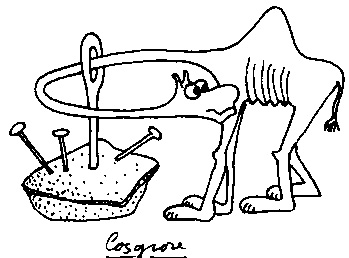Symplectic and Contact Geometry - Summer Tutorial 2003

|
Here is Gromov's symplectic camel.
Can you squeeze it through the eye of the needle
using only symplectic
transformations?
|
-
Instructor: Ciprian Manolescu
- Homepage:
http://www.people.fas.harvard.edu/~manolesc/symcon.html
-
E-mail: manolesc_at_fas.harvard.edu
-
Office: Science Center 431f
-
Office hours: Mondays and Wednesdays 3-4 pm and by appointment
Homework:
1. McDuff-Salamon, exercises 1.12, 1.13, 1.15, 3.10 (due Mon 7/7)
2. McDuff-Salamon, exercises 2.1, 2.13, 2.16, 2.25 (due Thu 7/10)
Outline:
Symplectic manifolds are an intermediate case between
real and complex (Kahler) manifolds. The original motivation for studying
them comes from physics: the phase space of a mechanical system,
describing both position and momentum, is in the most general case a
symplectic manifold. Symplectic manifolds still play an important role in
recent topics in physics, such as string theory. They have also proved
useful in understanding the structure of four-dimensional real manifolds.
Contact manifolds are the odd-dimensional analogues of symplectic
manifolds, and they appear naturally when one is interested in symplectic
structures on manifolds with boundary.
This tutorial will serve as an introduction to the study of symplectic
and
contact manifolds. We will discuss Hamiltonian mechanics and how
symplectic manifolds arise in physics. Then we will define symplectic,
complex, almost complex, and contact structures on a manifold, and give
lots of examples of each of them. Two important results that we will
prove are: Darboux's theorem on the local triviality of symplectic and
contact manifolds, and Martinet's theorem that every closed orientable
3-manifold admits a contact structure.
Prerequisites:
A solid knowledge of manifolds, differential
forms, and vector fields, at the level of Math 25/55 or 135.
Organization:
We will meet on Mondays and Thursdays in
Science Center 216, from 7:15 pm to 8:45 pm. The first class is on July 3
and the last on August 11. In the first four weeks of the course, there
will be lectures and optional homeworks. By late July each student should
choose a particular topic on which to write a short paper (5-7 pages) and
give an in-class presentation. The papers are due on the last day of
classes. They can be used to fulfill your junior paper requirement.
Topics to be covered in the first part of the course:
- Hamiltonian mechanics, Euler-Lagrange equations, the standard
symplectic structure on Euclidean space;
- linear symplectic geometry: the symplectic linear group, Lagrangian
and symplectic subspaces, the Maslov index;
- symplectic manifolds in general, hamiltonian vector fields, Darboux's
theorem;
- complex and almost complex structures with examples;
- Kahler manifolds and the Fubini-Study form;
- contact manifolds: definitions, examples, Darboux's theorem;
- contact structures on 3-manifolds and Martinet's theorem.
Suggestions for project topics:
- symplectic group actions and moment maps;
- more examples and constructions of symplectic manifolds: blowing up
and down, connected sums;
- Gromov's telescope construction;
- the Poincare-Birkhoff theorem;
- the group of symplectomorphisms and the flux homomorphism;
- the Hofer-Zehnder capacity;
- characteristic foliations of surfaces in contact manifolds;
- legendrian knots;
- J-holomorphic curves and Gromov's nonsqueezing theorem;
- Floer homology and the Arnold conjecture.
Textbook:
D. McDuff and D. Salamon, "Introduction to symplectic
topology," Oxford University Press, New York, 1998.
We will also use material from some additional sources, such as:
- A. Cannas da Silva, "Lectures on symplectic geometry," Springer
Verlag, Berlin, Heidelberg, 2001
- B. Aebischer et al., "Symplectic geometry," Progress in Math. 124,
Birkhauser, Basel, 1994
-
A. Weinstein, "Lectures on symplectic manifolds," American Mathematical
Society, Providence, 1977
- D. McDuff and D. Salamon, "J-holomorphic curves and quantum
cohomology,"
American Mathematical Society, Providence, 1994
- R. Berndt, "An introduction to symplectic geometry," Graduate Studies
in Math. vol. 26, AMS, Providence, 2001
- J. Etnyre, "Introductory lectures on contact geometry," online at
http://xxx.lanl.gov/abs/math.SG/0111118
- H. Geiges, "Contact geometry," in Handbook of Differential geometry
vol. 2, avaialble online at http://xxx.lanl.gov/abs/math.SG/0307242
- J. Martinet, "Formes de contact sur les varietes de dimension 3,"
Lecture
Notes in Math., Vol. 209, Springer, Berlin, 1971
- W. Thurston, "Three-dimensional geometry and topology," edited by Silvio
Levy. Princeton University Press, 1997

